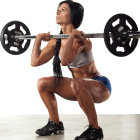 Q: What is meant by the term “quad dominant”?
Q: What is meant by the term “quad dominant”?
A: Quad dominant is a popular term used in sportsmedicine that refers to the idea that the quadriceps provides more force during movements than the hip.
Women are considered more likely to be quad dominant because they have wider hips than men, causing their upper-thigh bone to angle inward toward the primary lower thigh-bone more so than in men. As such, when women land after a jump, there is a tendency for the knees to buckle inward much more than a man’s knees would.
Taken to the extreme, that stress is believed to put women at a greater risk of suffering ACL injuries. The result is that a lot of strength coaches now spend a lot of time having women athletes performing instability exercises, such as squatting on rocker boards (and even Swiss balls!), trying to teach them to move safely and “properly.”
In my experience, athletes are often quad dominant due to improperly performed exercises and poorly designed workout programs that create structural imbalances. Specifically, their workouts neglect the hamstrings and fail to work the quadriceps through a full range of motion. For that reason the term can be useful to classify exercises as being quad or hip dominant.
Exercises such as deadlifts, reverse hypers and back extensions are “hip dominant”; exercises such as step-ups, lunges and leg presses are “quad dominant.”
When classifying an exercise in that regard, consider that there are degrees within the two categories. For example, back squats are more hip dominant than front squats. So an effective approach might be a compound set that supersets a front squat and a back squat, thereby switching the emphasis from the quads to the glutes and hamstrings.
In sports, athletes often must switch between hip-dominant and quad-dominant movements. For example, in a 100-meter sprint the start is more quad dominant, and as the athlete moves into the upright “sprint” posture, the action becomes more hip dominant. So to improve their start, sprinters might focus on a quad-dominant exercise such as pushing a sled.
In designing workouts, a simple approach would be to include the same number of quad-dominant exercises as hip-dominant exercises. For example, here is a fat-loss workout that combines a quad-dominant exercise, back squats, with a hip-dominant exercise, bent-knee deadlifts. It consists of only one giant set and may look easy on paper, but it’s extremely challenging.
A1) Barbell back squats, 3/2/1/0 tempo, 5 x 8-10
Rest 60 seconds
A2) Chinups, 3/0/1/2 tempo,
5 x 8-10
Rest 60 seconds
A3) Bent-knee deadlifts, 4/1/1/0 tempo, 5 x 8-10
Rest 60 seconds
A4) Flat-bench barbell bench presses, 3/2/1/0 tempo, 5 x 8-10
Rest 180 seconds
For someone whose lower back is relatively weak and who would have difficulty maintaining proper technique after bent-knee deadlifts, here is a variation of the workout:
A1) Barbell back squats, 3/2/1/0 tempo, 5 x 8-10
Rest 60 seconds
A2) Chinups, 3/0/1/2 tempo,
5 x 8-10
Rest 120 seconds
B1) Bent-knee deadlifts, 4/1/1/0 tempo, 5 x 8-10
Rest 60 seconds
B2) Flat-bench barbell bench presses, 3/2/1/0 tempo,
5 x 8-10
Rest 120 seconds
Consider these workouts as examples, not precise prescriptions designed specifically for you. You want to have a structurally balanced training program, but that doesn’t mean you must perform squats and deadlifts in the same workout. It could entail having a two-week training cycle that emphasizes the squat, followed by a two-week training cycle that emphasizes the deadlift. The idea is to look at the bigger picture—your workout design over several months—and make sure there is a balance between quad-dominant and hip-dominant exercises.
Editor’s note: Charles Poliquin is recognized as one of the world’s most suc-cessful strength coaches, having coached Olympic med-alists in 12 different sports, including the U.S. women’s track-and-field team for the 2000 Olympics. He’s spent years researching European journals (he’s fluent in English, French and German) and speaking with other coaches and scientists in his quest to optimize training methods. For more on his books, seminars and methods, visit www.CharlesPoliquin.com. Also, see his ad on page the opposite page. IM




















You must be logged in to post a comment Login